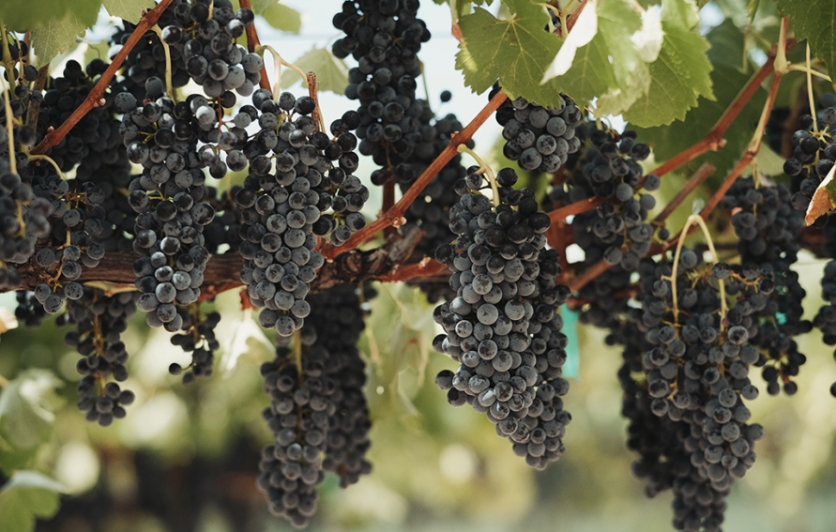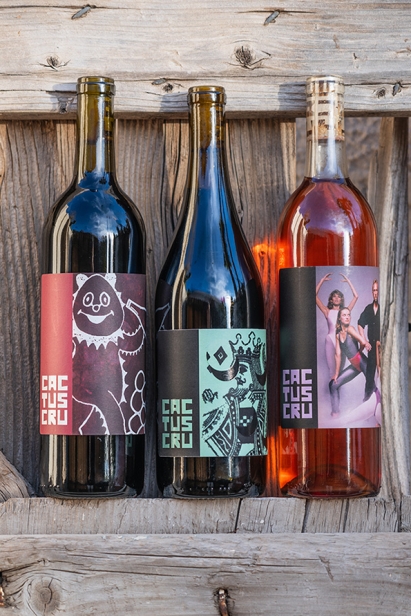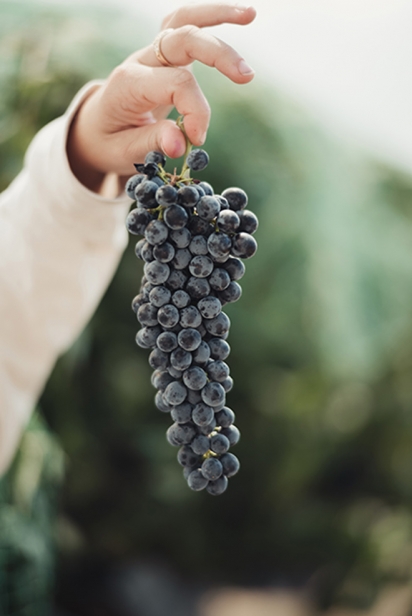Cactus Cru Wines
When Timo Geis was a boy, he collected wine barrels the way other boys collect baseball cards. His grandparents lived along La Route des Vins, a major wine road in Alsace on the German border in Northeast France.
“My first obsession was collecting small and medium-sized wine barrels at flea markets in Alsace with my grandparents,” Geis said. He collected dozens of them, including one so large he placed it outside in the family’s yard.
Born in the central French city of Limoges, Geis was raised between France and Sedona, AZ. His paternal grandparents always lived in Alsace, one of the world’s great wine-producing regions and a place where wine is intrinsic to the culture. Yet he doesn’t come from a winemaking family and there was little reason to think it would turn into a career choice, aside from his early fascination with the peculiar shape of barrels.
Today, Geis, 33, is the founder of Cactus Cru, one of Arizona’s newest wine labels that focuses on low-intervention winemaking from organic and sustainably farmed grapes.
While working in restaurants in the U.S. during college, he was required to have a basic level of knowledge about wine. At first, it was merely part of the job, but Geis became inspired by a co-worker who mentored and encouraged him to pursue certifications through the Court of Master Sommeliers.
He returned to Alsace as an intern and eventually went on to Spain, Italy and Germany, where he worked with small producers and learned about approaches to winemaking that encourage minimal intervention in the vineyards, the crush pad and the cellar.
In 2019, back home in Arizona, he started an import and distribution company with the idea of bringing small producers from Europe into the state, but just as he was getting started new tariffs threatened the industry and the COVID-19 pandemic froze supply chains.
The uncertainty prompted Geis to explore other options. He decided if he couldn’t import wine, he would learn how to make it, and enrolled in the Southwest Wine Center’s enology program at Yavapai College.
Without any vineyards of his own, he needed to source fruit and find facilities to partner with for his vision of Cactus Cru. The journey has led Geis to look at Arizona’s history to find insight on his future.
“Arizona modern wine history is not even, what, 50? It’s barely 50 years old, so there’s so much to be discovered,” he said.
The Modern Era
In the late 1800s, a fresh wave of settlers had brought commerce and a market for wine consumption to the newly designated Arizona territory, but the wine industry mimicked the boom-and-bust nature of other frontier ventures as it struggled to rival California.
There was likely little winemaking during the Spanish colonial period, despite common depictions of missionaries bringing grapevines to the region to produce sacramental wine. In fact, they obtained this with other necessities through larger supply routes.
Then, in 1920, Prohibition shuttered commercial activity throughout the U.S. Even after Prohibition was repealed in 1933, the wine industry in Arizona remained largely inactive for decades.
In the early 1970s, Gordon Dutt, a soil scientist at the University of Arizona, planted a series of experimental vineyards in Southern Arizona. He would soon go on to found Sonoita Vineyards, the state’s first commercial vineyard in 50 years.
In 1981, Dutt was part of a team of researchers who received a federal grant to study the suitability of viticulture in the Southwest. They published the “Four Corners Report,” which provided a crucial resource for farmers and grape growers in identifying the best soil and climates for grape varieties. The report showed that Arizona has all the right conditions for great winemaking.
Dutt helped establish Sonoita as the state’s first American Viticultural Area (AVA) in 1984 and the Arizona Wine Growers Association (AWGA) was also founded that year.
Today Arizona is home to more than 100 registered wineries, and producers like Callaghan Vineyards, Dos Cabezas and others regularly garner awards and national attention.
While Arizona’s modern wine industry may date only to the 1970s, Geis finds parallels going back even further. One of the first commercially successful winemakers, for example, was Henry Schuerman, a German immigrant who planted vineyards in the 1880s along Sedona’s Oak Creek near Geis’s childhood home.
Around that same time in the early communities of Prescott and Wickenburg, Schuerman’s predecessor, Daniel Hatz, experimented with vinifying Vitis arizonica, the state’s native varietal commonly known as “canyon grape” and selling it to the local population. Many of the settlers reached these communities by traveling the Hassayampa River and so became known as “Hassayampers.”
The first vineyard Geis partnered with to procure grapes from for Cactus Cru was Hassayampa Vineyard in Walnut Grove, a mining town along the river outside Prescott.
“First, there’s the Hassayampers. Then, [Schuerman’s] first vineyard was in Sedona,” said Geis. “That’s where I started making wine, was in Sedona.”
Now, Cactus Cru represents a new chapter in Arizona’s history by bringing his interpretation of natural wine to the state.
Cactus Cru
Back in Alsace, when Geis interned with a certified organic winery, he noticed something that surprised him. Once the fruit came in from the vineyards, sulfur dioxide (SO2) and commercial yeast were added prior to fermentation. He learned there are many commonly used additives in wine despite the grapes being farmed organically.
Sulfur dioxide or sulfites are a natural by-product of fermentation; however, additional larger quantities are often added at different stages in the winemaking process to help preserve freshness, color and shelf-life.
Soon after his time in Alsace, Geis visited a winery that used more low-intervention techniques, allowing the wine to ferment spontaneously from yeast on the skins of the grapes and in the air, rather than using commercially available yeast strains. These wines had no added SO2, were fermented in large terracotta amphora called qvevri, and macerated the juice of white grapes on their skins, referred to as a skin-contact or “orange” wine because of the resulting color.
It was Geis’s first education on natural wine, a style of low-intervention winemaking with roots in 1980s France, when like-minded winemakers and farmers eschewed the use of commercial additives and chemicals that had become widespread in industrial agriculture. Here, Geis said, something clicked for him.
When he returned to Arizona, initially he opened Selection Sauvage to bring European as well as domestic natural wines into the state, but when the pandemic and an increase in tariffs sent the industry into turmoil, Geis set his sights on creating a natural wine label in Arizona. At first not everyone was receptive to his specific vision.
“Everyone has their own winemaking style, but my goal is to make very-low-intervention wine with native yeast fermentations,” he said.
After finishing his program at the Southwest Wine Center, he sought to partner with a licensed winery for crushing and winemaking. Eventually, he found partnerships with both Michael Pierce at Bodega Pierce and Jason McClusky at Arizona Stronghold.
“Without them letting me do this, Cactus Cru would not be here today.”
Looking Forward
In 2022, Cactus Cru released their first commercially available bottle, called Gosse Négoce, a low-alcohol red wine made from 100% Cabernet Sauvignon harvested from Hassayampa Vineyards in 2021.
Their offerings now include a rosé of Barbera, also from Hassayampa; a Malvasia Bianca, from grapes farmed at Rhumb Line Vineyard in Willcox; and a Syrah from fruit grown at Red Tree Ranch Vineyards in the Chiricahua Mountains foothills.
“I’m a rookie winemaker,” Geis said. “I’m still learning every year about everything. So every year is a new chapter for me and a new learning experience.”
According to Geis, the only way to make great wine is to have healthy grapes—particularly for natural wine, since there is less ability to correct the wine with additives. In warm growing climates with alkaline soils like Arizona, grapes naturally produce lower acidity and so vineyards may be treated to lower the soil pH or acid may be added to the wine to create balance.
“I’ve found that for the style of wine that I’m making, which is essentially never adding acid, I want to work with varietals that have a healthy chemical balance, meaning the pH is in the ideal range,” Geis explained.
All three vineyards Cactus Cru sources fruit from are practicing organic, but are not certified, which Geis acknowledges can be costly. Still, he thinks having more certified organic vineyards in the future could benefit consumer confidence. He looks forward to more people entering the industry who share similar values and embrace low-intervention techniques.
For Cactus Cru, Geis hopes to one day have his own facilities for winemaking. He’s interested in opening an urban winery despite the unique challenges that it presents; he points out that in 1980 R.W. Webb Winery opened the state’s first licensed winery since Prohibition in a Tucson warehouse.
“I have a lot of respect for all these wineries [in Arizona], whether they’re making natural wine or not, for the way they’ve paved for this industry.”
Learn more at cactuscru.com or on Instagram @cactuscru








